December 2015, Issue #3
EXTINCTION/DEVOTION
TABLE OF CONTENTS
Editorial
Lise Weil
 Kristin Flyntz
Kristin Flyntz
I. EXTINCTION
Debra Magpie Earling
From The Lost Journals of Sacajewea
Melissa Kwasny
After•Word from Ghost Dance: the Poetics of Loss (Debra Magpie Earling)
Naeemeh Naeemaei
Dreams before Extinction
Deena Metzger
Our Radiant Lives
Mary Sutton
Her Body is Burning
Naomi Shihab Nye
My Grandmother Said
 Netanyahu
Netanyahu
Lena Khalaf Tuffaha
Arrest
Sara Wright
Tree Holocaust
Beverly Naidus
Curtain Call: Portable Altars for Grief and Gratitude
Marilyn DuHamel
Turning Point
Susan Cerulean
Bear Requiem
Margo Berdeshevsky
Our Safe Word
II. DEVOTION
Mei Mei Sanford
Serach Bat Asher Speaks
Lise Weil
First, a Mother: Interview with Megan Hollingsworth of
ex•tinc•tion wit•ness
Caroline Casey
Beauty from Brokenness: Interview with Lily Yeh
Sharon English
After•Word Our Call to Indigenous Consciousness: Taiaiake Alfred’s Wasáse
Cynthia Anderson
From the Beginning
 Nova
Nova
Anne Bergeron
Calling out the Names
Julie Gabrielli
Song of the Chesapeake
Nora Jamieson
I am Nothing without my Dead
Patricia Reis
After•Word Nora Jamieson’s Deranged
Rebecca Brams
The Bone in My Yard: a Story-Carrier’s Path
Lise Weil
Listening to Natural Law: Interview with Ayya Santacitta
Courtney Cable
After•Word Kenny Ausubel’s Dreaming the Future
Cynthia Travis
Offerings
Beverly Naidus
Curtain Call: Portable Altars for Grief and Gratitude
Seattle, 2015
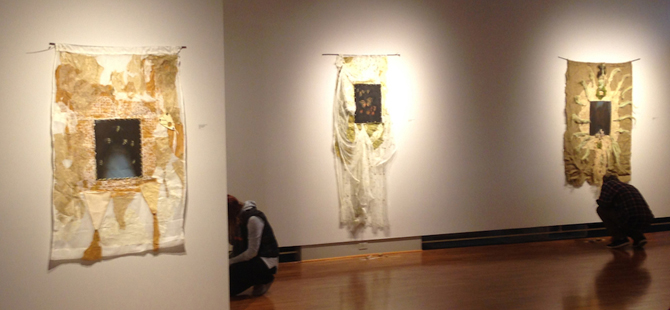 Overview of several altars installed at Karl Drerup Gallery, Plymouth State University, NH 2014
Overview of several altars installed at Karl Drerup Gallery, Plymouth State University, NH 2014
In the summer of 2014, I found myself making altars about extinction. My heart was breaking and I needed to find a way to process what I understood was happening to the world and its species. I wanted to make a series that would roll up and be easy to carry from place to place.
Typically, when I start working with any concept, I scavenge diverse materials and let my intuition dance. It’s a form of “contact improvisation” with words, materials and feelings, where I let the weight between each gesture shift, then find balance, and unexpected forms emerge. I may start with a bunch of questions, maybe even a confusion of thoughts about a particular topic, but the way to get there is mostly unknown. False starts can litter the studio and then get recycled.
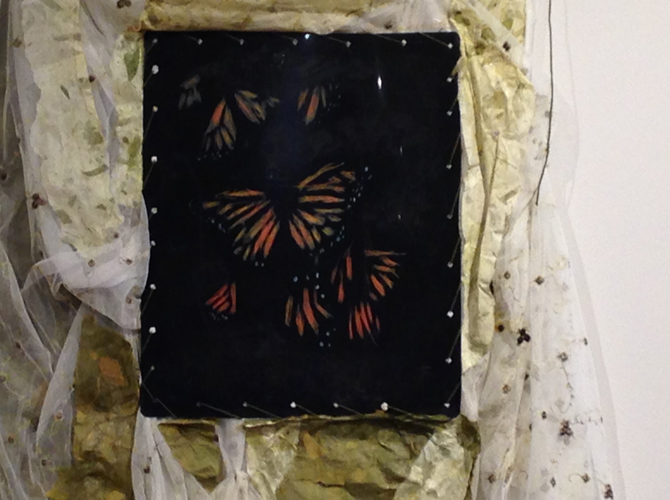 In Honor of Monarch Butterflies (detail) 2014
In Honor of Monarch Butterflies (detail) 2014
This time I started with something skeletal. I sewed remnants of cloth, burlap and old curtains, onto thin branches. I punched holes into the edges of old x-rays of my body and sewed them into a central space in each curtain. I was thinking about Tibetan Thangkas as devotional images, with their central imagery of the sacred. I journeyed into something I could not yet visualize, ripping out many threads as things began to gel.
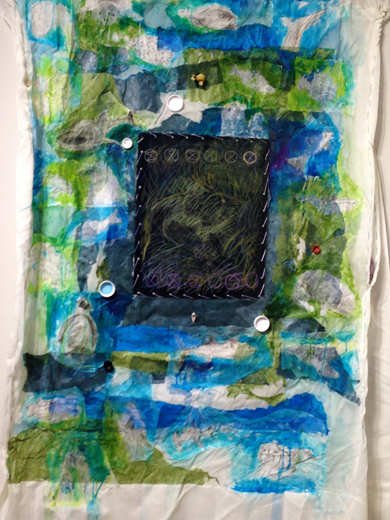 In Honor of the Creatures of the Sea, 2014
In Honor of the Creatures of the Sea, 2014
For a brief moment, I wanted to place dystopic images on these hanging altars, but I rejected that impulse early on. Dancing into the nightmare can be therapeutic, but my intention was of a different sort. I encouraged myself to make beauty that speaks about this precious moment, a beauty that expresses my gratitude for the sweet, imperfect contradictions in this life. In other words, when I began to open to the suffering, the grief of losing so much, somehow I found that beauty emerged.
I started listening to Joanna Macy (one of my early teachers) while I worked. In her talks and her writings she discusses the “Great Turning” and what might be necessary to shift our world into one that is concerned about future generations. She talks about the legacy we are leaving the future beings and she does it in a way that resonates deeply. I began to meditate on those generations to come, the ones that will be contending with a radioactive planet with fewer species and less access to clean water, clean air, topsoil, healthy food, shelter and any sort of well being. As I was stitching, I allowed images to dance, like hidden energy behind each curtain; images of people connecting through their pain to morph into vast networks of people educating each other, finding new tools for creating a just & healed planet, bubbling and juicy with diversity, fertility and possibility. I imagined people all over the planet turning their shared grief and gratitude into a resonant and luscious chorus that cannot be silenced until the shift occurs.
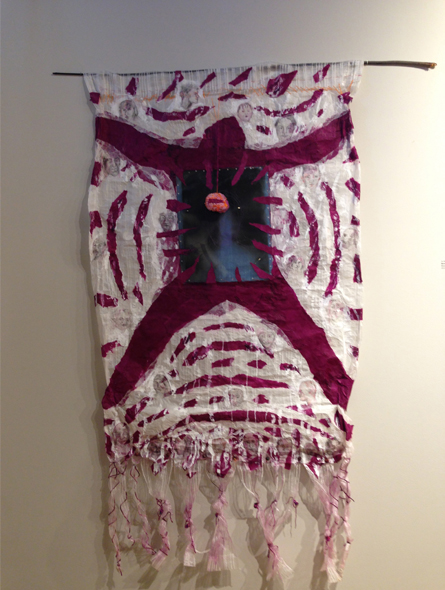 In Honor of Human Beings, 2014
In Honor of Human Beings, 2014
The twelve hanging altars were birthed almost simultaneously, in the sense that I worked on them all at the same time. The first to appear complete was in honor of honeybees, and then monarch butterflies arrived. Over the course of three months, altars to honor old growth trees, clean water, indigenous cultures, clean air, creatures of the land, the winged ones, clean energy, creatures of the sea, fertile soil and human beings emerged. Twelve in all, each one a piece of the puzzle we need to solve. Although there is so much more to mourn and experience with gratitude, I felt complete with this chapter.
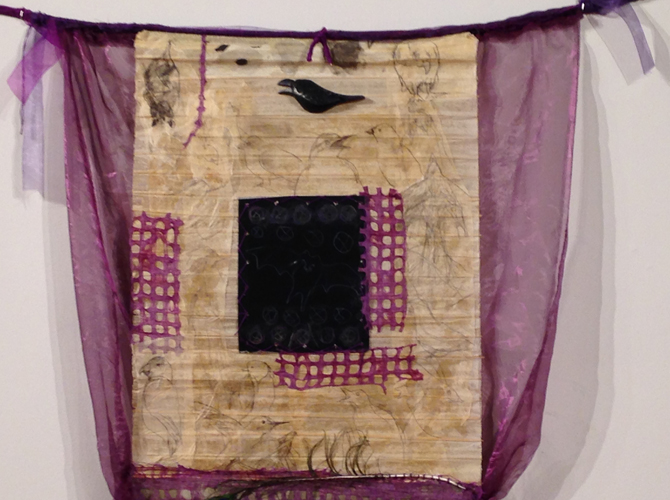 In Honor of the Winged Ones, 2014
In Honor of the Winged Ones, 2014
 In Honor of Honey Bees, 2014
In Honor of Honey Bees, 2014
When the altars are on display, the audience has an opportunity to share stories of their own grief and gratitude on a piece of tracing paper. A basket of small stones sits nearby. Contributors leave their “trace” under a stone at the foot of each wall hanging/altar. Visitors can read the contributions of others, each person bending down, in a modest form of homage, and moving stones as they do this.
As Alice Walker says, “For we can do nothing substantial toward changing our course on the planet, a destructive one, without rousing ourselves, individual by individual, and bringing our small, imperfect stones to the pile.”
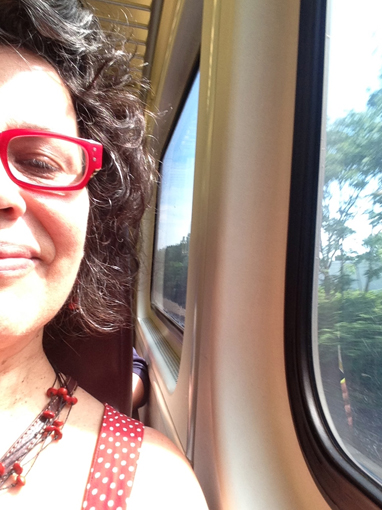
![]() Beverly Naidus - is an interdisciplinary artist who creates interactive installations, imagery and artifacts for site-specific performances, artist’s books, and both digital and mixed media works on paper. She facilitated and designed the permaculture-inspired, eco-art project, Eden Reframed, on Vashon Island, WA. She is an author, educator and facilitator of the Arts for Change network, an online pedagogical project focused on socially engaged art. Early recognition in the NYC and Los Angeles art worlds offered her many opportunities to exhibit her interactive installations and other work in diverse venues, including mainstream museums and city streets. Inspired by lived experience, topics in her art focus on environmental and social issues. She is the author of Arts for Change: Teaching Outside the Frame and numerous essays. Her teaching career includes work as a teaching artist at NYC museums, Carleton College, Cal State Long Beach, Hampshire College, Goddard College and the Institute for Social Ecology. She facilitates a unique, interdisciplinary, socially engaged, studio arts curriculum, for the UW Tacoma campus and leads workshops and discussion groups in her Seattle studio. She is a cofounder of the collective ARTifACTs currently designing the project “We Almost Didn’t Make It,” a multidisciplinary, nomadic project that will engaged audiences in a dialog with their descendants. Her website is http://www.beverlynaidus.net and her eco-art project’s blog is www.edenreframed.blogspot.com
Beverly Naidus - is an interdisciplinary artist who creates interactive installations, imagery and artifacts for site-specific performances, artist’s books, and both digital and mixed media works on paper. She facilitated and designed the permaculture-inspired, eco-art project, Eden Reframed, on Vashon Island, WA. She is an author, educator and facilitator of the Arts for Change network, an online pedagogical project focused on socially engaged art. Early recognition in the NYC and Los Angeles art worlds offered her many opportunities to exhibit her interactive installations and other work in diverse venues, including mainstream museums and city streets. Inspired by lived experience, topics in her art focus on environmental and social issues. She is the author of Arts for Change: Teaching Outside the Frame and numerous essays. Her teaching career includes work as a teaching artist at NYC museums, Carleton College, Cal State Long Beach, Hampshire College, Goddard College and the Institute for Social Ecology. She facilitates a unique, interdisciplinary, socially engaged, studio arts curriculum, for the UW Tacoma campus and leads workshops and discussion groups in her Seattle studio. She is a cofounder of the collective ARTifACTs currently designing the project “We Almost Didn’t Make It,” a multidisciplinary, nomadic project that will engaged audiences in a dialog with their descendants. Her website is http://www.beverlynaidus.net and her eco-art project’s blog is www.edenreframed.blogspot.com
Want to comment on any Issue of Dark Matter, fill out the form here.
Copyright © 2014-2021 Dark Matter: Women Witnessing - All rights reserved to individual authors and artists.
Email: Editor@DarkMatterWomenWitnessing.com
Please report any problems with this site to webmaven@DarkMatterWomenWitnessing.com
